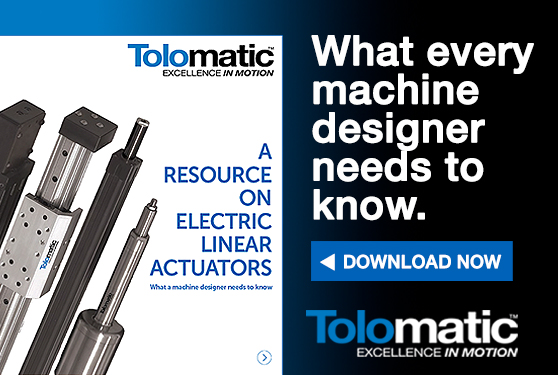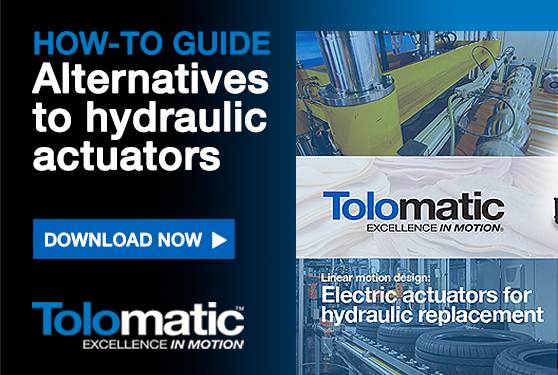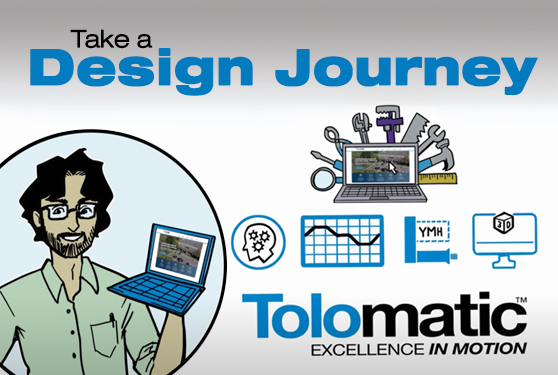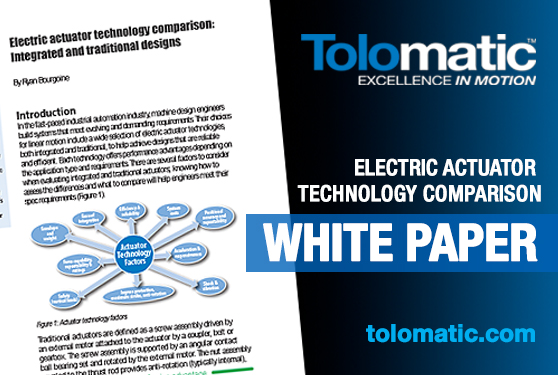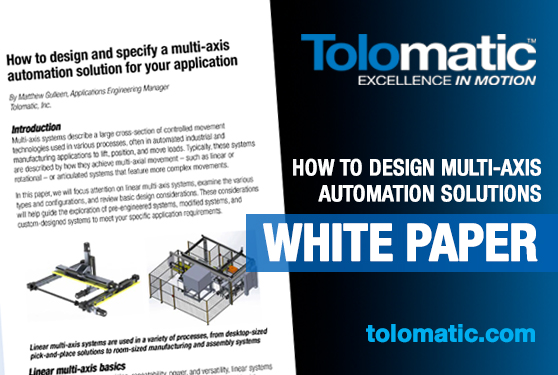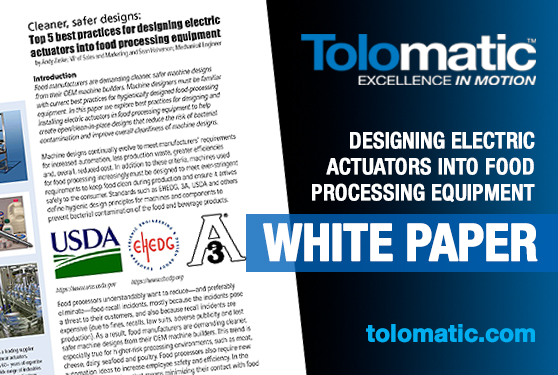
Accelerating the world with innovative motion technology
Excellence in Motion® for over 65 years. For decades, Tolomatic has manufactured innovative automation components and linear motion solutions that are made-to-order and made to last. From our industrial electrical linear actuators to pneumatic actuators, gearboxes, and brakes, our motion solutions are moving businesses forward. Tolomatic’s electric linear and pneumatic actuators are used in a variety of industries, including the packaging, material handling, medical, food processing, automotive, semiconductor, and general automation industries. Over 35% of our business comes from custom product solutions facilitated by our in-house engineering team that collaborates directly with design engineers and OEMs on their unique application requirements. Tolomatic products are made with USA engineering, design, and key technologies. Our global service centers in the USA, China, Germany, and Mexico provide excellent customer service to manufacturers around the world. Download FREE eBookUnderstand the design essentials of linear actuators for machine automation
A RESOURCE ON ELECTRIC LINEAR ACTUATORS is what machine designers need to know when considering an electric, pneumatic, or hydraulic linear actuator for their application. This eBook, produced by Tolomatic, provides a comparative evaluation of linear actuation technologies, with a focus on the distinct advantages of electrical actuator solutions. The guide illustrates the key differences, advantages, and challenges of each type of linear actuator. It explores the numerous design considerations of electrical actuators, including position control, accuracy, repeatability, rod vs. rodless solutions, screw and motor selection, system installation, applications, and more.
The decision of whether to use an electric, pneumatic, or hydraulic linear actuator is crucial for engineers when specifying a linear actuator. A pneumatic cylinder has advantages — ease of use, lower cost — but carries inefficiencies in operation with potential compressed air leaks. A hydraulic cylinder can provide high-thrust capabilities in a variety of environments, but they can be prone to fluid leaks, which can present risks to product quality and the environment. For a growing number of applications, next-generation electrical actuators are emerging as the choice for their ability to handle complex motion profiles with precise control of speed, acceleration, deceleration, and force, along with adaptability, efficiency, and integration with motion control and data collection systems.
Engineer’s guide to replacing problematic hydraulic cylinders with high-force electric actuators
ELECTRIC ACTUATORS FOR HYDRAULIC REPLACEMENT deliver greater flexibility in motion control capabilities for many legacy machines that utilize hydraulic motion control, offering new multi-position control and accuracy, enhanced control of velocity, output force, and complex control of all these motion variables in real-time. Electromechanical actuators, coupled with a servo drive and motor system, provide infinite, closed-loop control over position, with accuracy and repeatability levels far beyond the capabilities of a hydraulic system. While hydraulic cylinders have been and continue to be an industrial manufacturing workhorse, they are no longer the only viable technology for high-force applications. This eBook from Tolomatic examines how new, high-force electric linear actuators are capable of delivering the power of hydraulics in many applications while offering far greater efficiency and positioning control without the costly maintenance, downtime, and inherent environmental and contamination hazards associated with hydraulic fluid power. This guide offers a pragmatic exploration of replacing hydraulic cylinders with electric actuators in legacy machines and new system designs, including comprehensive total cost of ownership analysis, sizing and converting calculations and tools, engineering resources, and numerous application examples where electric actuators are delivering powerful advantages in manufacturing and process solutions.
Take the Tolomatic Design Journey for engineering success
If your project needs precise linear motion control with heavy-duty electric actuators that are made specifically for your application, discover the powerful design tools, resources, and solutions offered by Tolomatic.
“Design Journey with Tolomatic” is a brief, entertaining look at how the industry leader in linear motion partners with customers to provide a wide range of solutions that are built to order, with numerous available modification options, fast delivery of production models or prototypes, and collaboration on custom designs.
In under three minutes, the Design Journey reveals the design tools and engineering resources available online at Tolomatic.com, including selection tools and SizeIt sizing software that automatically calculates and determines the right actuator based on your speed, force, and lifecycle requirements. Tolomatic’s “Your Motor Here” program enables easy adaptation to motor-of-choice along with 3D CAD models of your finished design to verify fit. And our “Ask the Engineer” tool puts you in touch directly with our experienced team.
Take the Tolomatic Design Journey now and explore Online Tools for Machine Design Engineers
Understand the key choices between integrated and traditional electric actuator technologies
Today, machine design engineers are presented with numerous choices for linear motion applications, including a wide selection of electric actuator technologies – both integrated and traditional. Traditional actuators are defined as screw assemblies driven by an external motor attached to the actuator by a coupler, belt, or gearbox. Integrated actuators are defined as a screw assembly rigidly coupled to and driven by an internal hollow-core servo motor.
Each technology offers performance advantages depending on the application type and requirements, and there are several considerations when evaluating integrated and traditional actuators. This white paper from Tolomatic explains how to assess the differences and how to compare technologies in ways that will help you meet the spec and performance requirements of individual applications.
“Electric Actuator Technology Comparison” reveals various technical attributes and considerations when evaluating between the implementation of a traditional actuator, or the selection of an integrated actuator solution, including:
• Ease of integration
• Size considerations, including envelope and weight
• System costs
• Performance considerations including ingress protection, maximum stroke and anti-rotation capabilities
• Efficiency and reliability
• Positional accuracy and repeatability
• Force capability, repeatability and ratings
• Acceleration and responsiveness
• Shock and vibration
• Safety considerations (vertical load)
How to Design and Specify a Multi-Axis Automation Solution for Your Application
Linear multi-axis systems offer controlled movement, achieving unparalleled accuracy, high cycle speeds, and load capabilities in equipment and manufacturing automation applications. Versatile solutions range from featherweight pick-and-place applications to room-sized gantry manufacturing and assembly systems that accommodate extended stroke lengths and heavy payloads.
In this white paper, sponsored by Tolomatic, Inc., learn how to design and specify a multi-axis automation solution for your application, examine various configurations, review basic design considerations, and access advanced online sizing software and design tools. Design and visualize a multi-axis system to synchronize linear motion in up to six axes, executing the most complex trajectories and highly dynamic movements. Explore pre-engineered systems, modified systems, and custom-designed systems to meet your specific application requirements.
The white paper describes a three-step process for designing and integrating a multi-axis system, factoring design considerations including load, force, speed, travel, stroke length, accuracy, and duty cycle. Different types of multi-axis systems are examined, along with component selection and application examples.
Top 5 best practices for designing electric actuators into food processing equipment
Current food-processing equipment designs must comply with strict health and safety hygiene standards required by the EHEDG, 3A, USDA, FSMA, and others. To comply and reduce food-safety incidents, food manufacturers require cleaner and safer machines from their OEM designers and machine builders. In this white paper sponsored by Tolomatic, we explore the best practices for designing and installing electric actuators in food processing equipment to help create open/clean-in-place designs that reduce the risk of bacterial contamination and improve overall cleanliness.
For more information
Please enter your email to learn more.
